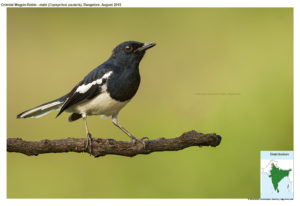Oriental Magpie Robin (Male)

Oriental Magpie Robin Copsychus saularis
Etymology :
- Copsychus : Greek word for Blackbird
- Saularis: Latin word for the Sun
Vernacular Names : Hindi: Dhaiyal, Dhaiyar,Sans: Bharat dadhyak, Pun: Dhial, M.P: Kali sooi chiria,Munda: Hatiure,Bhil: Kabro, Ben: Dhaiyal, Dhaiyar,Ass: Dahikataraa, Mani: Uchinao, Lepcha: Zannid-pho, Cachar: Dao-gophu-gachim,Guj: Daiyad, Daiyad, Mar: Dominga, Dayal, Ta: Gundu-kavitchan, Vannati-kuruvi, Pattukari-kuruvi, Te: Pedda nalanchi, Sarala-gadu,Mal: Mannattipeechi,Kan: Madivala, Suvvi,Sinh: Polkichcha
Distribution in India: Widespread resident in India.
Description: Size of 19–21 cm; wt. of 29–41 g. The male of nominate race is glossy blue-black above and on breast, with white belly with patchy buff tinge around vent, white bands along wing, white sides of longish graduated tail, black bill and legs. The female is similar to male but black replaced with grey, except on wings. Juvenile is dark brownish-grey with blackish mottling above, whitish bands on wing, rufous wing edgings, mottled dark on buff on face, breast and flanks, belly to vent whitish. It is found in dry deciduous forest but preferring presence of shady evergreen trees, peat swamp-forest, open teak forest, banks of large rivers through forest, forest edge along logging tracks, bamboo, secondary jungle, gardens, compounds, orchards, parkland, coconut groves, tall tree plantations, field patches, hedges, village environs, creekside scrub jungle and beach strand vegetation. It is found from lowlands to 1900 m.
Food habits: It eats insects like crickets, beetles, locustids, ants, firebugs, caterpillars, wasps, termites and flies and their maggots, invertebrates like, earthworms, molluscs, millipedes, crabs, spiders, and small vertebrates such as geckos and fish. It also eats nectar, seeds and fallen wild fruit. It feeds largely on ground, hopping about in upright stance, with tail pumping over back, wings partly drooped; also hawks winged termites.
Breeding habits: They breed in Apr–Jul in India and all year in Sri Lanka; Feb–Aug in China; Jan–Sept in SE Asia; Apr–Jun in Philippines; Jan–May in N Borneo; Mar–Jul in Sumatra and Apr–Jun in Java. The nest a small ,bulky untidy pad of grass, rootlets, pine needles, palm fronds, fibers, hair, feathers, snakeskin, placed up in hole in old wall, roof of house, bamboo clump, discarded hollowed bamboo pole, overhanging roots, cavity in bank, tree trunk or branch. The nest is reused for subsequent broods. They lay a clutch of 2-5 eggs. The incubation period is 12–13 days.